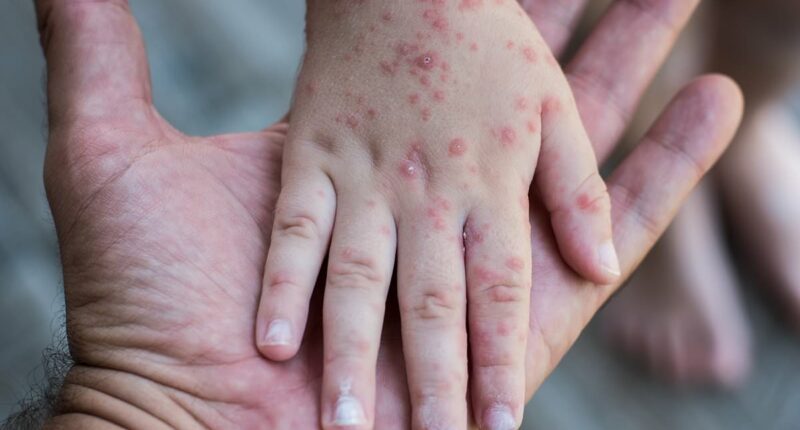Share this @internewscast.com
New York is preparing for a potential outbreak of another highly transmissible virus, as hand, foot, and mouth disease (HFMD) cases rise across the eastern United States.
Currently, New York City is dealing with a Legionnaires’ disease outbreak, affecting 67 individuals and resulting in three deaths. Meanwhile, doctors in Staten Island are expressing concerns about an increase in HFMD cases.
A few instances have already been identified, with rising reports from several states such as Maryland, Pennsylvania, New Jersey, Virginia, Ohio, Kansas, and West Virginia.
HFMD is a viral disease that can lead to painful lesions forming on the hands, mouth and feet as well as fever and a sore throat.
This disease primarily affects children under 10 years old, as adults usually have immune systems robust enough to prevent infection. HFMD outbreaks are most common in nurseries and schools, but immunocompromised adults are also vulnerable.
The CDC does not track cases of the virus so there is little data available on case numbers.
Dr. Edith Bracho-Sanchez, a pediatrician at Columbia University Irving Medical Center in New York, noted an increase in HFMD cases recently compared to the last ten years.
Similarly, Dr. Natasha Burgert, a pediatrician from Kansas and a spokesperson for the American Academy of Pediatrics, has observed the same pattern.

Manhattan is gearing up for an outbreak of another highly contagious virus, as numbers of hand, foot and mouth disease (HFMD) cases spike across the US
‘What I’m seeing in my own practice mirrors the surge my colleagues are reporting nationwide,’ she told The New York Times.
HFMD is caused by the virus coxsackievirus 16 and there is no vaccine for the condition.
It can be passed through the air or by coming into close contact with a person who hasn’t washed their hands after using the bathroom.
HFMD infections tend to spike in the summer and early fall because children are more likely to mix in environments where the disease can spread, such as at summer camps, pools and theme parks, as well as the start of school.
Some studies also suggest that warmer and more humid weather in the summer months may be more favorable for the survival and transmission of the viruses that cause HFMD.
HFMD typically causes fever, vomiting and a rash covering the mouth, hands and feet that clears up within 10 days.
But in very young patients, the illness can be much more serious and lead to seizures, triggered by inflammation of the fluid surrounding the brain.
The disease is highly transmissible, spread via contact with fluids from an infected person, such as from blisters, and by swallowing infected water.
Experts warn that water parks can spread the highly contagious disease if their water has not been treated properly, leaving children at risk of infection.
In Philadelphia, a water park was closed for a day in July after a child who had visited the location contracted HFMD.

Experts warn that water parks can spread the highly contagious disease if their water has not been treated properly, leaving youngsters at risk of infection (stock image)
About 10 to 15million cases of HFMD are recorded in the US every year, estimates suggest, mostly among children under five years old.
Those who are infected are recommended to take over-the-counter pain medications to help relieve fever and pain caused by mouth sores.
Patients are also told to drink plenty of water to avoid dehydration, saying this may happen because mouth sores make it painful to swallow.
Children diagnosed with the disease should avoid contact with others for at least seven days in order to dodge them spreading the infection.




